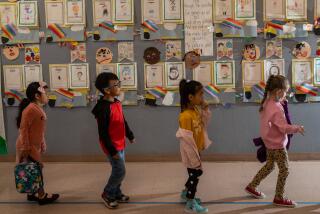Hey, Poo-Poo Head, Let’s Be Friends: Childhood Teasing Needn’t Be Traumatic
- Share via
Are you concerned that other kids are calling your child “cactus head?” Worried that your son is telling his playmate he “throws like a girl?” Or do you flinch at parents who hold out a cookie, then pull it back so their child can’t reach it?
Relax, says researcher Dacher Keltner, professor of psychology at UC Berkeley. Most teasing is not only benign, but can also help children negotiate conflicts, socialize with one another and express affection.
Most studies on teasing acknowledge some forms have positive benefits but tend to focus on the dark side--when teasing crosses the line into bullying or harassment. That type of childhood teasing, particularly when it targets appearance, has been linked with serious problems later in life, such as depression, low self-esteem and eating disorders. Keltner’s research, to be published in the March issue of the journal Psychological Bulletin, offers a comprehensive look at what he calls the subtle art of “playful provocation.”
In general, Keltner says many Americans tend to be too thin-skinned about teasing and lump all types together, missing the point. “Teasing is a form of play,” he says, in which children learn over time how to provoke one another with an aggressive yet lighthearted edge.
“Our culture gets it wrong when we say teasing is why kids at Columbine shot other kids, and we should try to eliminate teasing on the playground,” he says. If we do, he says, we risk “losing important social behavior that has a lot of constructive uses.”
Children as young as 5 understand that people communicate in ways that aren’t always literal, he says. They can distinguish playful sarcasm (“Nice haircut, did the dog chew it up?”) from real criticism, for instance. Their own teasing develops from rudimentary insults (“You poo-poo head”) to more subtle, often humorous, comments by age 10 (“Your mother’s so skinny, she can take a shower and not get wet”), says Keltner. By sixth grade, 60% to 70% of their teasing is aimed at promoting friendship, he says.
In fact, the most skilled teasers among 9- to 14-year-olds are usually those with the most friends, he says. In a study this year of boys at a Minnesota basketball camp, Keltner asked one group of boys to cheer a free-thrower, and another to taunt him. Three days later, when asked whether they had made any new friends at camp, the boys who teased each other were more likely to name each other as friends, he says.
*
Skilled teasers--young and old--send a message that they feel close to the person they are teasing, Keltner says. A sharply personal gibe can promote greater affection when the teased person recognizes certain signals of playful intent and reconciles with the teaser, he says. Teasers convey that they are joking through laughter, knowing looks and nudges, and tone of voice, he says.
Keltner says he was first intrigued by teasing as a graduate student at UC San Francisco studying facial expression and emotion. “One of the things that makes people embarrassed is to be teased,” he says. “We hate this emotion, yet we inflict it on each other all the time. I thought there must be something good about it.” Over the past five years, he has become a respected figure in the small but growing field, publishing dozens of papers. Teachers and child-care workers heard Keltner’s research last week at a workshop held by the university’s Institute of Human Development, which aims to apply the latest research to real classrooms.
Keltner says teasing is neither practiced nor adored universally. Northern European and Japanese cultures tend to frown on teasing; some others have developed sophisticated, ritualized patterns of teasing. In those cultures, families may begin teasing children as young as 2, he says.
In an ethnographic study of Mexican American families, researchers observed an uncle in a large family tell a young girl, “You’re ugly.” Keltner says the teasing prompted other relatives to rush to the girl’s defense, saying how pretty she was. “They would hug her, rub her hair and refute the uncle,” turning the experience into something positive.
In some Mediterranean cultures, he says, parents and adolescent boys tease each other about their eccentricities. “It turns adolescent turmoil into something a little bit more playful.”
*
A famous 1962 study by University of Pennsylvania folklorist Roger D. Abrahams found that some inner-city African American youths were being taught how to respond to racism and discrimination through ritualized taunts called “playing the dozens.”
Teasing also offers a gentle way to learn about group norms. If the teaser points out a mistake or deviation in a joking way, it helps kids to take themselves less seriously. “It lets the person know it’s not do or die, that the self should not crumble in a pile of dust because of it,” Keltner says.
People who work with children confirm that teasing can sometimes help newcomers fit into the group. At the Boys and Girls Club of the Foothills in Monrovia, children recently teased a new boy that his Pokemon T-shirt was dumb. “That was how they broke him in,” says Jesus Amezquita, program specialist. Rather than taking it personally, the boy took the teasing in stride, he says. “After that, they became friends.”
Sometimes, the teaser is simply seeking attention--such as the boy who called a girl named Magdalena “Macarena.” When the girl complained, Amezquita spoke to the boy, who apologized.
*
Naturally, the impact of teasing depends on the perception of the person being teased, psychologists say. “We believe now that if people already have low self-esteem or an issue that concerns them, then it’s going to affect them more,” says J. Kevin Thompson, a professor of psychology at the University of South Florida and specialist in body image.
The teaser’s intent and topic is also crucial, he says. Though Thompson agrees that most teasing is probably benign, he says it crosses the line when it focuses on a person’s looks, when it is frequent, one-sided or meant to exert power and control over another.
Several studies have documented the link between childhood teasing and serious self-image problems in later life, says Thompson, lead author of “Exacting Beauty: Theory Assessments and Treatment of Body Image Disturbance” (American Psychological Assn., 1999.) In one study, college students who reported having body image or self-esteem problems recalled a history of childhood teasing. In another, 12-year-olds who reported being teased about their appearance showed self-esteem problems, depression, and eating disturbances when they were re-tested three years later.
Teasing carries as much weight in eating disorders as parental modeling or genetic history, he says, and may be as powerful as media influence. “It’s a huge influence. It’s almost always brought up when you interview people with eating disorders or extreme body image problems as a background factor. Especially if they were overweight.”
Girls who are teased by their fathers about their weight are particularly vulnerable, he says. Some develop an obsessive-compulsive disorder about their appearance that can dominate their lives and lead them to “severe social problems associated with high suicide rate and depression,” he says.
The difference between positive and negative teasing may be obvious to parents and teachers, Keltner says. “When I hear my daughter being teased over personal, physical things, I know it’s serious. . . . If she comes home with far-out nicknames and is similarly distressed, maybe she is overreacting a little and we have to work on that.”
Teachers and parents often hope children will work it out themselves, advising them either to laugh it off, or tease back. Others insist adults must be vigilant and intervene because what appears to be benign teasing can quickly escalate into trouble.
On her “Judge Judy” television show Friday, Judith Sheindlin heard the case of an 8-year-old boy who had teased another persistently about liking a certain girl. Eventually, the teased boy slapped the teaser, who fell against a pole, hitting his head. His mother was hoping to collect the costs of medical care from the other parent. Unsympathetic, the judge admonished the boy from the bench, “The whole thing wouldn’t have happened if you hadn’t started to tease.”
Some youth workers say children need to be corrected because they can be mean without realizing it. Some are direct with comments like “You stink” and “You’re ugly.” Boys in particular know they can start a confrontation by insulting someone’s mother or sister. Girls might focus on someone’s clothes, Keltner says.
At the Santa Monica Boys and Girls Club, “We listen to their tone and whether or not they say it like they mean it in a bad way,” says M.E. Raco, associate executive director. When teasing escalates into aggression, he says, the child may be suspended or given a “timeout.”
Keltner understands those who worry about teasing. But he also wonders if they aren’t robbing children of a chance to learn “an amazing practice that allows people to play, to pretend, to express affection, communicate norms and morals, explore romantic possibilities and negotiate their way in work and family.”
For those who are able to practice the skill, he says, “Teasing just gets better with age.”


